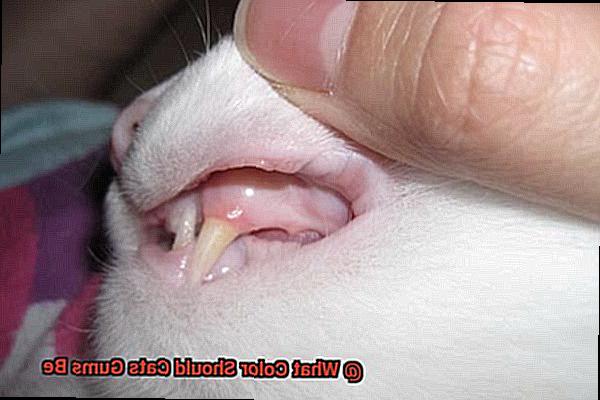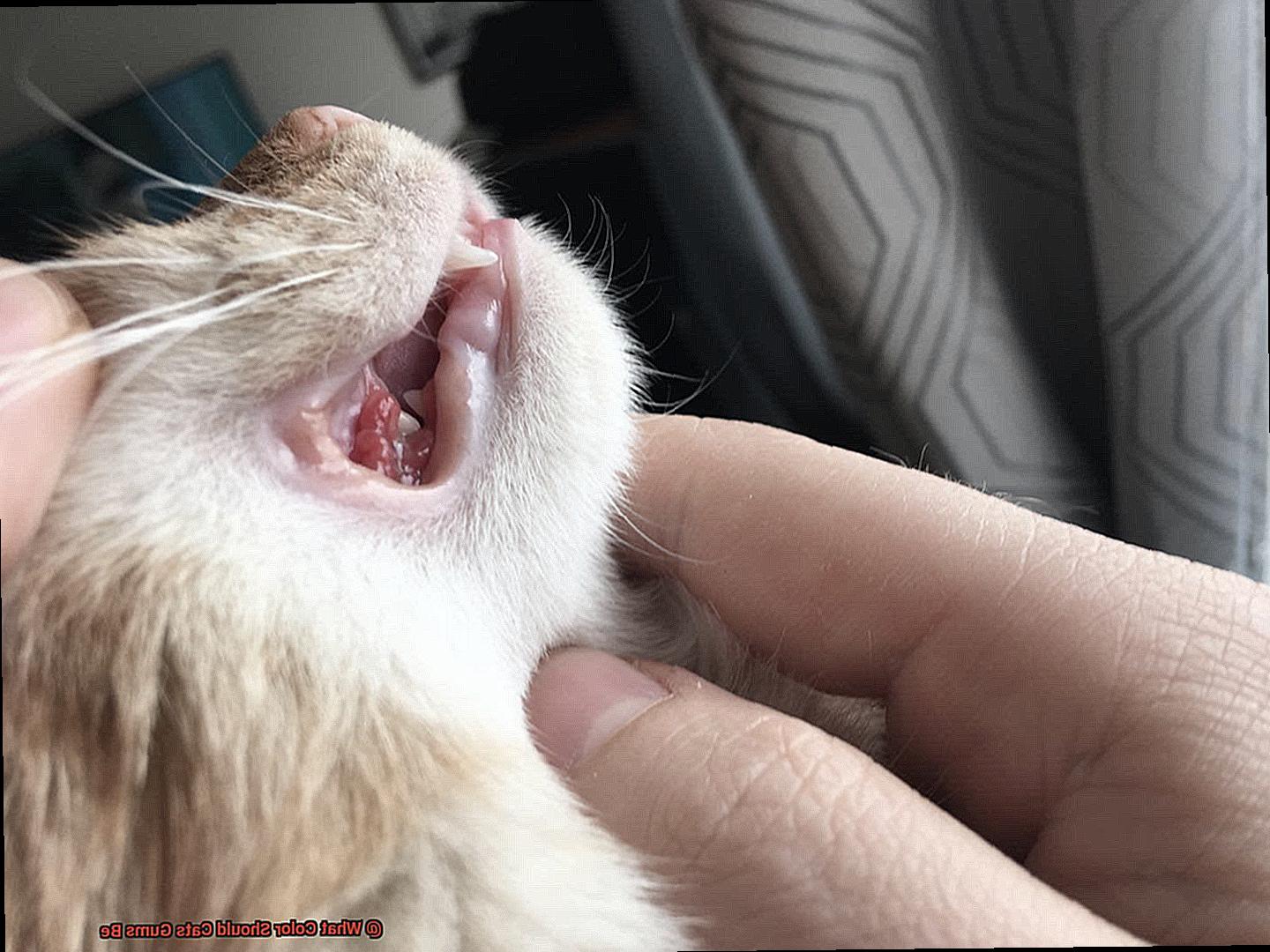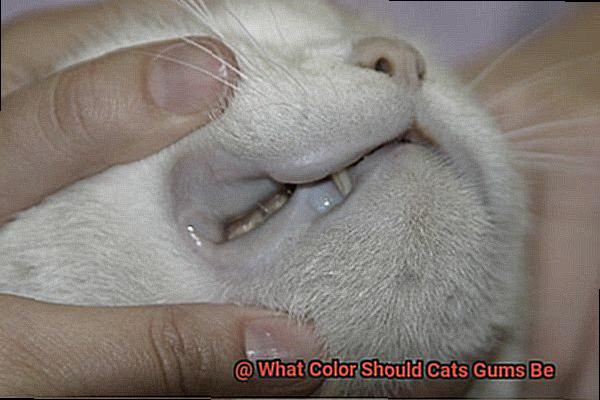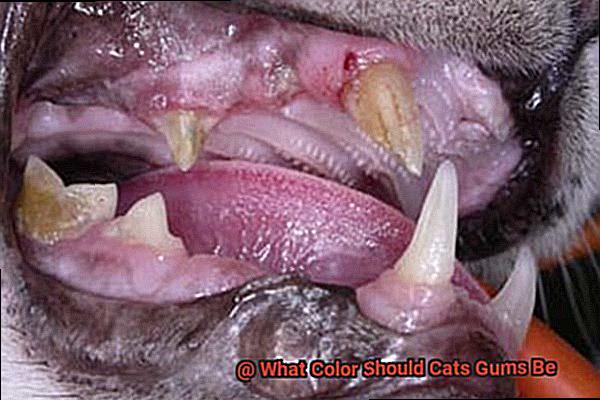It’s crucial to keep a close eye on your furry friend’s health.
One of the most telling signs of their well-being is the color of their gums. Your cat’s gums can provide valuable insight into their overall health and serve as an early warning system for potential health issues.
So, what exactly should you be looking for when it comes to the color of your cat’s gums? Before we dive in, let’s take a moment to appreciate just how incredible cats are.
They’re graceful, independent creatures that have captured our hearts for centuries. But despite their stoic nature, they’re not immune to health problems – including gum disease.
Regular check-ups and monitoring the color of your cat’s gums is essential for maintaining their oral health. In this blog post, we’ll explore the various colors of cat gums and what they mean.

From healthy pink to alarming shades of red or blueish-gray, we’ll cover it all. We’ll also discuss the causes behind these colors and offer tips on how to prevent gum disease from developing in the first place.
And if you do notice any concerning changes in your cat’s gum color? We’ll guide you on when it’s time to seek professional help.
So get ready to learn more about this important aspect of feline health – because when it comes to keeping our beloved cats happy and healthy, every detail matters.
The Importance of Monitoring Cat’s Gum Color
One way to do this is by monitoring their gum color.
Believe it or not, a cat’s gums can provide valuable insights into their overall health and wellbeing. Just like how our skin can indicate when we’re feeling sick or unwell, a cat’s gums should be pink in color and have a smooth texture.
If you notice any changes in color or texture, it could be an indication of an underlying health issue. For example, if your cat’s gums appear pale or white, it could be a sign of anemia or low red blood cell count.
If they appear blue or purple, it could be an indication of respiratory distress or lack of oxygen in the body. And if they appear yellow, it could be a sign of liver disease or jaundice.
In addition to color, it’s also important to pay attention to the moisture and texture of your cat’s gums. They should feel smooth and moist to the touch.

Dry or sticky gums could be a sign of dehydration, while rough gums could indicate dental issues such as tartar buildup or gingivitis. Regularly monitoring your cat’s gum color can help detect potential health issues early on, allowing for prompt treatment and intervention.
In severe cases, gum discoloration could indicate a life-threatening condition that requires immediate medical attention. As a responsible cat owner, you should make a habit of checking your cat’s gum color regularly as part of their routine wellness check-up.
Signs of a Healthy Cat’s Gums
One of the most vital aspects of your cat’s health is their gums.
By paying attention to your cat’s gums, you can determine whether they’re in good shape or if they require veterinary care. So, what exactly should you look out for when checking your cat’s gums?
Firstly, healthy gums should be a delightful pale pink color, just like the hue of bubblegum. Not only that, but they should also be smooth and moist to the touch, almost like a freshly polished surface.
Another telltale sign of healthy gums is the presence of a clear line between the gums and teeth, known as the gingival margin. This line should be well-defined and pink in color, resembling a neat little fence line protecting your cat’s teeth.
When you gently press on your cat’s gums with your finger, they should quickly turn white and return to their normal pink color within two seconds. This is called capillary refill time and indicates good blood flow to the gums.
Think of it as if your cat’s gums are doing cardio exercises every day. Healthy cat gums should not be swollen or inflamed, nor should there be any visible lesions or ulcers.
If you observe any of these indications, it may indicate an underlying health condition that necessitates veterinary attention. Remember to regularly check your cat’s gums for any signs of illness or disease, as early detection can help prevent more serious problems down the road.
Remember to look for pale pink color, smooth texture, well-defined gingival margin, and quick capillary refill time when assessing your cat’s gum health.
What Pale Gums May Indicate
One way to ensure their wellbeing is by checking their gums regularly.
Healthy gums should be pale pink with a smooth texture and clear gingival margin. However, if you notice that your cat’s gums appear paler than usual, it could be an indication of an underlying health problem.
One potential reason for pale gums in cats is anemia. Anemia occurs when there is a shortage of red blood cells in the body, which can be caused by parasites like fleas or ticks or underlying health conditions like kidney disease or cancer.
If your cat’s gums are pale and they’re also experiencing symptoms such as lethargy or loss of appetite, it’s crucial to get them to a veterinary clinic as soon as possible. Shock is another potential cause of pale gums in cats.
This can happen after a traumatic injury or accident and is characterized by a drop in blood pressure and decreased blood flow to vital organs. Along with pale gums, other signs of shock include rapid breathing, weak pulse, and cold extremities.
If you suspect that your cat is in shock, seek emergency veterinary care immediately. Dehydration is another possible cause of pale gums in cats.
If your cat isn’t drinking enough water or has been vomiting or experiencing diarrhea, they may become dehydrated. Dehydration can lead to several health problems if left untreated, so it’s important to encourage your cat to drink water regularly and seek veterinary care if they’re showing signs of dehydration.

By monitoring your cat’s overall health and seeking veterinary care whenever necessary, you can help keep your feline friend happy and healthy for years to come.
What Blue or Purple Gums May Indicate
One of the ways you can do this is by checking their gums regularly.
Normally, a cat’s gums should be pale pink with a smooth texture and a strong gingival margin. But what if the gums appear blue or purple?
If you notice that your cat’s gums have turned blue or purple, it’s a sign that they are not getting enough oxygenated blood flow to their tissues. This condition is called cyanosis and is a serious indication of an underlying problem.
Therefore, it’s crucial to seek veterinary attention immediately. Respiratory distress can be one of the potential causes of cyanosis in cats.
If your cat is having trouble breathing, their body may not be getting enough oxygen. Respiratory difficulties can stem from various conditions such as asthma, pneumonia, or heart failure.
Another possible cause of cyanosis is anemia, which occurs when there aren’t enough red blood cells to carry oxygen throughout the body. In some cases, cyanosis may also be a symptom of poisoning or toxicity.
Certain toxins can interfere with the body’s ability to deliver oxygen to the tissues, causing them to turn blue or purple. Other signs of poisoning may include vomiting, diarrhea, seizures, or lethargy.
It’s important to remember that blue or purple gums are never normal in cats and should be taken seriously. Seeking prompt medical attention from your veterinarian is crucial.
Your vet will help diagnose the underlying cause and provide appropriate treatment to ensure your cat’s health and well-being. In conclusion, as a responsible cat owner, it’s essential to keep a close eye on your feline friend’s overall health and well-being by regularly checking their gums.
If you notice any changes, especially blue or purple gums, don’t hesitate to seek urgent medical attention right away.
What Yellow Gums May Indicate
One important aspect to keep an eye on is the color of their gums.
If you notice that your cat’s gums have turned yellow, it’s crucial to act fast as it could indicate an underlying health condition. Yellow gums in cats can be a sign of various health issues.
One potential cause is jaundice, which occurs when the liver is not functioning correctly. This can lead to a buildup of bilirubin in the bloodstream, causing yellowing of the gums, eyes, and skin.
Think of it as a traffic jam on a highway; when there’s a blockage, things turn red and return to normalcy once the issue is resolved. Anemia is another possible culprit behind yellow gums in cats, which results from too few red blood cells in the body.
Parasites, nutritional deficiencies, or underlying diseases can cause anemia. If your cat’s gums appear yellow, it could indicate severe anemia and call for immediate veterinary attention.
It’s like a warning light on your car’s dashboard, reminding you to act promptly before things get worse. Yellow gums may also indicate problems with the kidneys.
If the kidneys cannot filter waste products from the blood effectively, toxins build up and cause yellowing of the gums and other tissues in the body. It’s like a backed-up drain that needs fixing before it overflows.
If you notice that your cat’s gums are yellow, don’t hesitate to take them to the veterinarian for a thorough examination. The vet will perform tests to determine the underlying cause of the yellowing and develop an appropriate treatment plan.
Remember that early intervention can make all the difference in your cat’s health and happiness. In conclusion, yellow gums in cats are never normal and should be taken seriously.

Keep an eye on your cat’s wellbeing and schedule regular check-ups with your veterinarian to catch any issues early on.
What White Gums May Indicate
It’s time to take action by bringing your cat to the veterinarian.
White gums in cats can indicate a range of health issues, from mild to severe. When checking your cat’s gums, watch out for any signs of discoloration such as white patches or a pale appearance.
One possible cause of white gums is anemia, a condition where there are not enough red blood cells in the body. This can be caused by several factors such as nutritional deficiencies, infections, or autoimmune disorders.
Anemic cats may also experience lethargy, weakness, and loss of appetite. Dehydration can also lead to white gums.
If your cat isn’t drinking enough water or is experiencing vomiting or diarrhea, they may become dehydrated and develop pale gums. In severe cases, dehydration can be life-threatening and requires immediate veterinary attention.

White gums may also be an indication of certain cancers or infections such as feline leukemia virus (FeLV) or feline immunodeficiency virus (FIV). Such conditions weaken the immune system and make your cat more susceptible to infections and illnesses.
If you notice that your cat has white gums, it’s crucial to take them to a veterinarian for evaluation. Your vet will perform a physical exam and run diagnostic tests to determine the underlying cause of the discoloration and develop an appropriate treatment plan.
Early detection and treatment can improve your cat’s prognosis and overall health. Just like we routinely check our car’s dashboard for warning lights, it’s also important to check our cat’s gums regularly for any signs of discoloration.
Bright Red Gums and Other Considerations
While you may think that your cat’s gums are just a small part of their overall wellbeing, it’s actually one of the most important indicators of their health.
Firstly, it’s important to note that some cats may naturally have reddish gums.
However, if you notice a sudden change in your cat’s gum color, it could be a sign of an underlying health issue. One possible cause of bright red gums is gingivitis, which is inflammation of the gums.
This can occur due to poor dental hygiene, resulting in the buildup of plaque and bacteria in your cat’s mouth. Signs of gingivitis may include bad breath, yellow or brown teeth, and bleeding gums.
Another potential cause of bright red gums is anemia. Anemia occurs when there is a decrease in red blood cells or hemoglobin in the blood, which can lead to a lack of oxygen in the body.
While this often results in pale gums, in some cases, anemia can cause the gums to become bright red instead. It’s crucial to keep an eye on your cat’s gum color and overall oral health.
Regularly brushing your cat’s teeth and providing them with dental treats and toys can prevent dental issues from arising in the first place. If you do notice any sudden changes or abnormalities, it’s best to schedule a visit with your veterinarian for a check-up.
They can help determine the underlying cause and recommend appropriate treatment options. Remember that taking care of your cat’s dental health is just as important as taking care of your own.
Catching any potential issues early can make all the difference in ensuring your furry friend stays healthy and happy for years to come.
Conclusion
As a cat owner, it’s crucial to keep a watchful eye on your feline friend’s health.
Your cat’s gums can provide valuable information about their overall well-being and serve as an early warning system for potential health problems. That’s why monitoring their gum color is so important.
Healthy gums should be pale pink with a smooth texture and a strong gingival margin. However, any changes in color or texture could indicate an underlying health condition that needs attention.
For instance, if your cat’s gums are pale or white, this may be a sign of anemia or low red blood cell count. On the other hand, blue or purple gums may suggest respiratory distress or oxygen deficiency in the body.
And if they appear yellow, it could be indicative of liver disease or jaundice. In this blog post, we covered everything from healthy pink to obnoxious shades of red or blueish gray.
By being proactive in monitoring your cat’s gum health and seeking veterinary care as often as possible, you can ensure your furry friend stays happy and healthy for years to come.







